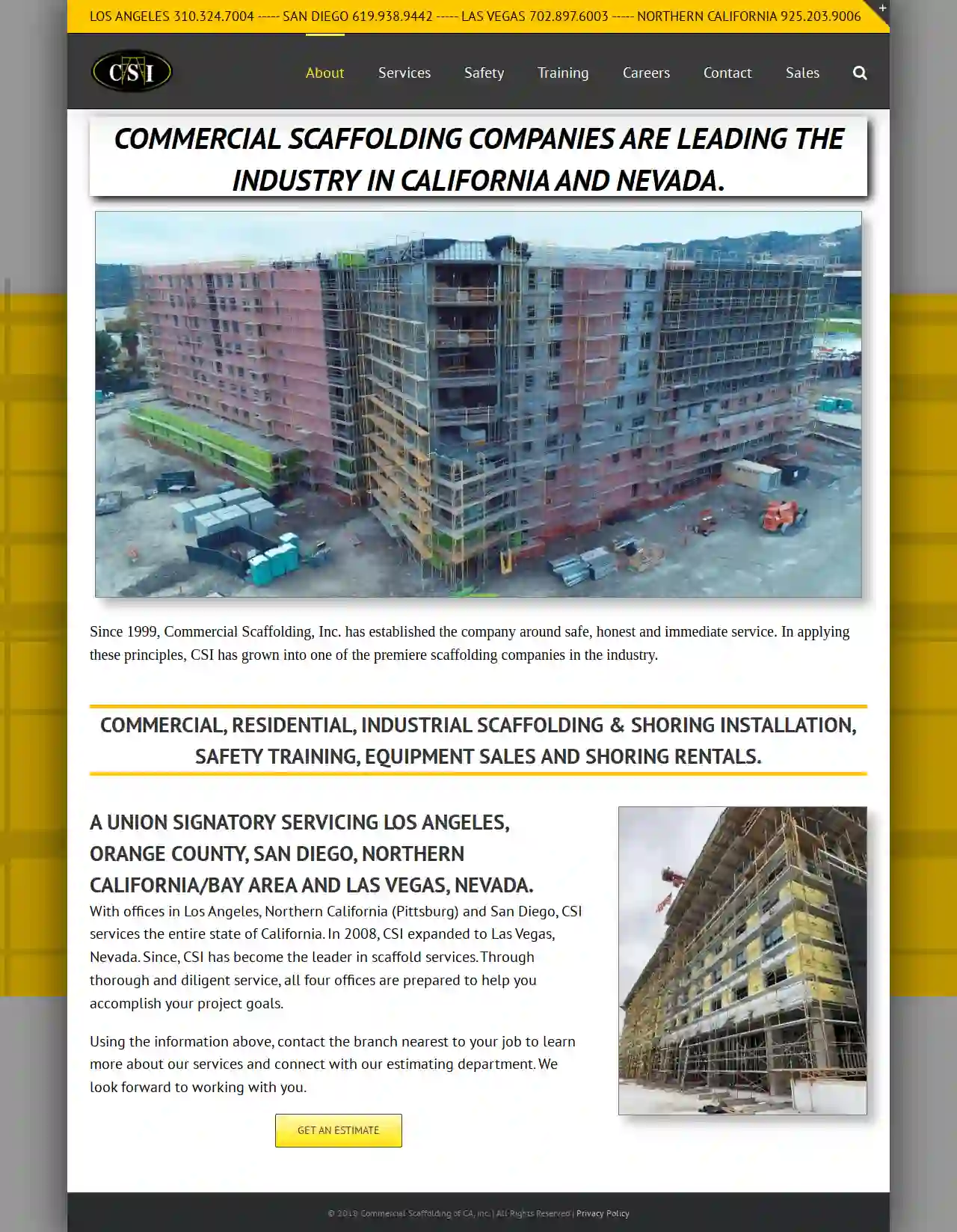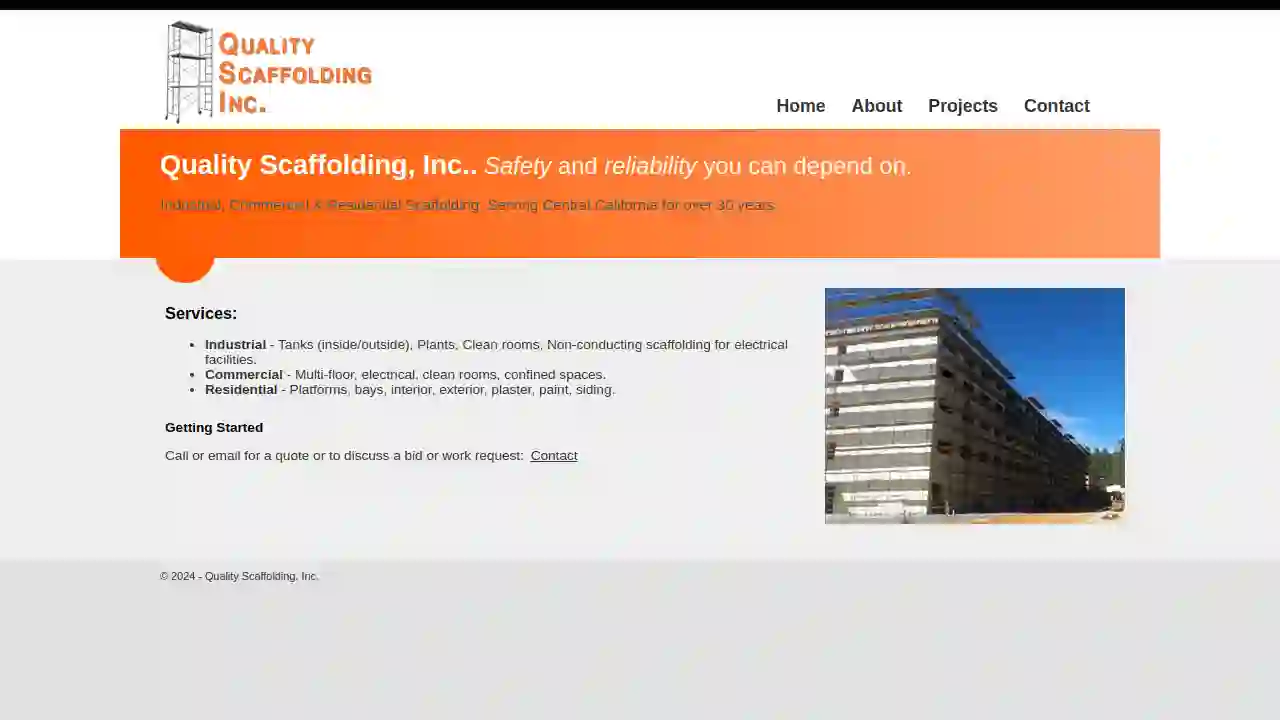Scaffolding Companies Loma Linda
Find Scaffolding Experts in Loma Linda
Get 3 FREE Construction Scaffolding quotes for your project today! Compare profiles, reviews, accreditations, portfolio, etc... and choose the best service.

South Bay Scaffold & Ladder
3.54 reviews15209 S. Avalon Blvd, Gardena, 90248, USAt South Bay Scaffold & Ladder, Company Inc., we've been providing superior scaffold erection services to residential and commercial customers in Los Angeles and Orange County since 1965. Our team of experts is dedicated to delivering exceptional service at every opportunity. Whether you need dependable service personnel for your project, we're your contractor of choice. Our services include commercial and residential scaffold erection, plaster scaffolds, sidewalk canopies, stairways, custom homes, hillside specialists, platforms, and stair towers. Rolling towers are also available. We're conveniently located at 15209 S. Avalon Blvd in Gardena, just five blocks East of the 110 Freeway. Call us today at 310-965-9565 to discuss your scaffolding needs.
- Services
- Why Us?
- Accreditations
- Our Team
- Gallery
Get Quote
Commercial Scaffolding of California, Inc.
4.813 reviewsLos Angeles, USCommercial Scaffolding, Inc. (CSI) is a leading scaffolding company in California and Nevada, providing safe, honest, and immediate service since 1999. With offices in Los Angeles, Northern California, San Diego, and Las Vegas, CSI offers a range of services including commercial, residential, and industrial scaffolding and shoring installation, safety training, equipment sales, and shoring rentals. The company is a union signatory, dedicated to helping clients achieve their project goals.
- Services
- Why Us?
- Gallery
Get Quote
Marshall Scaffold
4.511 reviews3351 Industrial DR, Suite 3, Santa Rosa, 95403, USLeading the Northern California Scaffold industry since 1964. Certified DVBE / SBPW / SBM. Marshall Scaffold and Supply sells and rents quality scaffolding. They also have bleachers, stages and shoring structures available to rent. They offer setup and dismantling services as well. Company Philosophy “It’s very important to us to keep our word and do everything that we say that we’ll do. We have a list of ‘ten commandments’ for running a business that we live by. We realize that without customers we would not have a company, so we always put the needs of the customer first and foremost.” Our Team A Dedicated Team: Our Greatest Asset Marshall Scaffold takes great pride in its outstanding team of experts. President JUSTIN MILLER Justin Miller is a native of Sonoma county, CA. Justin entered the Scaffold Industry in 1996 after proudly serving in the United States Marine Corps.
- Services
- Why Us?
- Accreditations
- Our Team
- Testimonials
- Gallery
Get Quote
Scaffolding San Francisco
51 reviews123 Scaffolding St, San Francisco, CA, 94103, USThe leading Bay Area supplier of the highest quality scaffold. We offer a complete range of services, from rental and sales to erecting & dismantling. Our team is committed to safety, reliability, and resourcefulness, ensuring customer satisfaction and adhering to OSHA standards.
- Services
- Why Us?
- Accreditations
- Our Team
- Testimonials
- Gallery
Get Quote
Ready Equipment Rental Inc.
421 reviews3969 N Sierra Way, San Bernardino, 92405, USAt Ready Equipment Rental, we have been providing our customers in the greater San Bernardino - Riverside Counties with an extensive variety of quality equipment rentals and tool rentals since 1988. From floor sanders to tile saws, utility trailers to tillers, tractors and bobcats to pressure washer's, we have the rental equipment and tools you need to build, maintain, power, move, or clean your projects. We are family owned, conveniently located at 3969 N Sierra Way, in San Bernardino Just north of the 210 Freeway and Waterman ave. We are here to help anyway we can for all your equipment rental and tool rental needs. Ask us about our affordable delivery and pickup, new and used equipment for sale.
- Services
- Why Us?
- Gallery
Get Quote
Royal Bay Scaffold, LLC
512 reviews4096 Piedmont Avenue Suite#616, Oakland, 94611, USRoyal Bay Scaffold is a scaffolding rental and services company based in Oakland, California. We provide superior scaffold solutions, reliable services, and competitive pricing. Our team members have 14 years of experience in the industry, and our company was established in 2017. We offer a range of services, including erecting and dismantling scaffold, pedestrian walkways, netting/mesh, and system & walk-thru frames scaffolds. We service all trades and are committed to safety, with a focus on OSHA safety rules and regulations. At Royal Bay Scaffold, we take pride in providing quality and safety services. We understand the importance of safety in the workplace and strive to maintain our reputation as skilled scaffolders. Our team members are dedicated to providing excellent service and ensuring that our clients' projects are completed safely and efficiently.
- Services
- Why Us?
- Accreditations
- Gallery
Get Quote
Quality Scaffolding, Inc.
4.25 reviews123 Scaffolding Lane, Scaffolding City, SC, 12345, USQuality Scaffolding, Inc. is a leading provider of scaffolding solutions, offering safety and reliability that you can depend on. With over 30 years of experience serving Central California, they specialize in industrial, commercial, and residential scaffolding. Their services include tanks, plants, clean rooms, non-conducting scaffolding for electrical facilities, multi-floor, electrical, clean rooms, confined spaces, platforms, bays, interior, exterior, plaster, and paint, and siding. To get started, customers can call or email for a quote or to discuss a bid or work request.
- Services
- Why Us?
- Accreditations
- Our Team
- Testimonials
- Gallery
Get Quote
Ganahl Lumber
4.4378 reviewsLaguna Beach, CA, 1765 Laguna Canyon Rd, 92651, USSince 1884, we have been a family and employee owned business selling building supplies and hardware for pro contractors and DIY enthusiasts alike. Our products include tools, paint, building materials, millwork, doors & windows. We are committed to providing quality hardware, lumber and building materials for professional contractors and homeowners throughout Southern California. Come visit our lumber yards and hardware store in: Anaheim, Buena Park, Capistrano Beach, Corona, Costa Mesa, Laguna Beach, Lake Forest, Los Alamitos, Northridge, Pasadena, and South Bay.
- Services
- Why Us?
- Accreditations
- Our Team
- Gallery
Get Quote
BrandSafway Solutions Richmond
35 reviews123 Main St, Richmond, 23219, USAt BrandSafway, we are committed to providing innovative, safe, and efficient solutions to our customers in the Richmond area. With a strong focus on customer satisfaction, we offer a wide range of services, including scaffolding, forming and shoring, and industrial services. Our team of experts is dedicated to delivering exceptional results, and we take pride in our ability to adapt to the unique needs of each project. With a rich history dating back to 1919, BrandSafway has established itself as a leader in the access and industrial services industry. Our commitment to safety, quality, and customer satisfaction has earned us a reputation as a trusted partner for construction, industrial, and infrastructure projects.
- Services
- Why Us?
- Accreditations
- Our Team
- Testimonials
Get Quote
OC Construction & Consulting, Inc
4.726 reviews2277 Harbor Blvd, Ste 317, Costa Mesa, 92626, USOC Construction and Consulting, Inc. is a licensed full-service remodeling and construction management company in Orange County, located in Newport Beach, CA. With over 30 years of experience in construction and general contracting, we aim to make the commercial and home remodeling process hassle-free for our clients. Our team of skilled professionals is dedicated to providing exceptional service and quality craftsmanship that exceeds expectations. We understand that every client has unique needs and preferences, which is why we take a personalized approach to each project.
- Services
- Why Us?
- Accreditations
- Testimonials
- Gallery
Get Quote
Over 2,353+ Scaffolding Businesses registered
Our scaffolding pros operate in Loma Linda and surroundings!
ScaffoldingHQ has curated and vetted the Best Scaffolding Contractors in Loma Linda. Find the most reliable business today.
Frequently Asked Questions About Scaffolding Companies
- A temporary structure with a larger platform for workers and materials.
- Offers greater stability and working space.
- Suitable for tasks requiring movement and multiple workers.
- Used for higher elevations and more complex projects.
- Used for reaching specific points at height for short durations.
- Less stable than scaffolding, requiring more caution and balance.
- Not suitable for tasks involving heavy materials or extended work periods.
- Encroaches onto public property (sidewalks, roads): Permits are usually needed from the local council or highway authority.
- Exceeds a certain height: Scaffolding above a specified height often requires a permit.
- Is erected in a conservation area or near a listed building: Special considerations and permits may apply.
- Regulations: Local regulations often specify minimum inspection intervals.
- Project Type and Duration: Long-term projects or those in challenging environments may require more frequent inspections.
- Weather Conditions: Severe weather (storms, high winds) can necessitate additional inspections.
- Any Alterations or Modifications: Any changes to the scaffolding structure require re-inspection.
What is the difference between a scaffold and a ladder?
Scaffolding:
Can I erect scaffolding myself?
Do I need a permit for scaffolding in the USA?
How often should scaffolding be inspected?
What is the difference between a scaffold and a ladder?
Scaffolding:
- A temporary structure with a larger platform for workers and materials.
- Offers greater stability and working space.
- Suitable for tasks requiring movement and multiple workers.
- Used for higher elevations and more complex projects.
- Used for reaching specific points at height for short durations.
- Less stable than scaffolding, requiring more caution and balance.
- Not suitable for tasks involving heavy materials or extended work periods.
Can I erect scaffolding myself?
Do I need a permit for scaffolding in the USA?
- Encroaches onto public property (sidewalks, roads): Permits are usually needed from the local council or highway authority.
- Exceeds a certain height: Scaffolding above a specified height often requires a permit.
- Is erected in a conservation area or near a listed building: Special considerations and permits may apply.
How often should scaffolding be inspected?
- Regulations: Local regulations often specify minimum inspection intervals.
- Project Type and Duration: Long-term projects or those in challenging environments may require more frequent inspections.
- Weather Conditions: Severe weather (storms, high winds) can necessitate additional inspections.
- Any Alterations or Modifications: Any changes to the scaffolding structure require re-inspection.